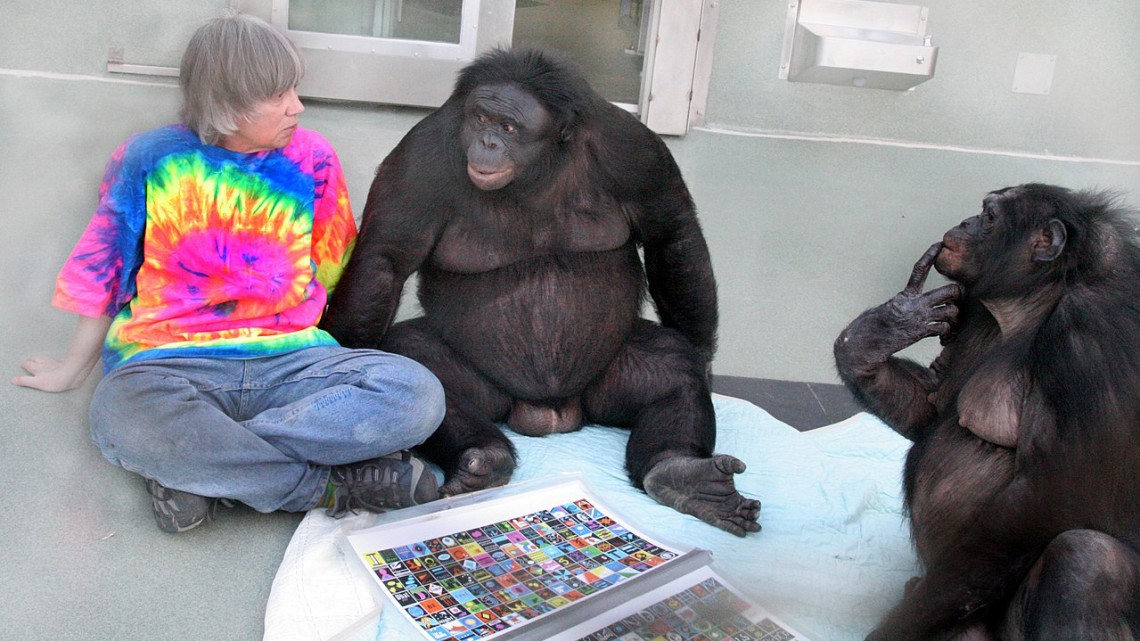
Bonobos Kanzi and Panbanisha with researcher Sue Savage-Rumbaugh.
Workshop explores ape-human communication
By Linda B. Glaser
Drawing, making fire, using language and creating stone tools are considered the “suite” of characteristics that signaled either the appearance of language or perhaps the arrival of a new species.
Bonobos (pygmee chimpanzees) have demonstrated all of these abilities after seeing them modeled. Videos of bonobos making and using stone tools and communicating using lexigrams (arbitrary symbols) opened “Eloquence of the Apes: A Trans-Disciplinary Workshop on Apes, Language and Communication,” held Oct. 20-21 at Cornell and featuring primatologist Sue Savage-Rumbaugh and her research.
The workshop examined questions related to apes, language and communication, bringing researchers from multiple disciplines to examine and reassess the language of our closest relatives, encompassing orangutans, gorillas, chimpanzees, bonobos, as well as modern humans and their fossilized ancestors.
Savage-Rumbaugh began her work with apes and language in the hope that she could help developmentally challenged children who had failed to acquire language. It soon became clear to her, she said, that the traditional approach to teaching apes to communicate was fundamentally flawed. Language, as Laurent Dubreuil, professor of Romance studies, noted in his talk, is about dialogue, not conditioned responses.
Savage-Rumbaugh immersed the apes in the same kind of language-rich, interactive environment that humans are raised in, with intensive human interaction and the need for meaningful communication. “We now know that our brains are not only very plastic, but that they grow new neurons at a rapid rate. Humans start behaving in new ways because of cultural changes,” said Savage-Rumbaugh. Bonobos share 99 percent of their genome with humans, and their nervous systems are equally flexible, she said.
The workshop sessions were divided into three themes: evolution and origin of communication in human and nonhuman primates, what language brings to apes, and the apes and the humanists. Cornell presenters included Dubreuil, Morten Christiansen, professor of psychology and cognitive science,and Barbara Finlay, the Kenan Professor Emerita of Psychology.
Christiansen spoke about “Language Evolution Through the Bottleneck: From Milliseconds to Millennia,” arguing that “linguistic structure is a product of cultural evolution, not biological adaptation.” He advocated for uncovering the constraints on language that work across evolution, acquisition and processing.
Finlay spoke on “Human Eloquence Arising in a Unique Ape Life History.” Human exceptionalism, she said, arises not from brains or longevity, but from the timing of birth and weaning, menopause and fertility.
The concluding roundtable, “The Apes and the Humanists,” featured humanists and social scientists including Cathy Caruth, the Rhodes Professor in the Humanities; Peter Gilgen, associate professor of German studies; and Sonia Ragir, professor emerita of anthropology, animal behavior and conservation at Hunter College.
Caruth drew on her work with trauma and human vulnerability. She noted that the growing field of trauma studies offers one perspective on nonhuman communication; the question of speechlessness is a significant one in trauma work, she said.
Gilgen addressed the long-standing question of whether animals suffer, in order to question the practices of domination and imprisonment of our closest biological relatives. For example, he asked, when apes do not respond during experiments, is it because they are not “in the mood”?
The enthusiasm demonstrated at the workshop by participants from numerous disciplines is carrying over into new collaborations – even, perhaps, a cross-disciplinary institute for language studies or the origins of culture, said Dubreuil. “Not just about chimps and bonobos. After all, we’re apes too.”
Dubreuil and Savage-Rumbaugh are working on a book, “Dialogues and the Human Ape,” that explores philosophical big-picture questions such as what is human, what is ape and what is the nature of thought. The book is scheduled to be released next year.
Another collaborative project will create video testimonies of people who have worked with the apes. According to Caruth, video testimonies are a genre arising partly out of work with Holocaust survivors. Caruth is collaborating with Dubreuil on the project.
Linda B. Glaser is a staff writer for the College of Arts and Sciences.
Media Contact
Get Cornell news delivered right to your inbox.
Subscribe